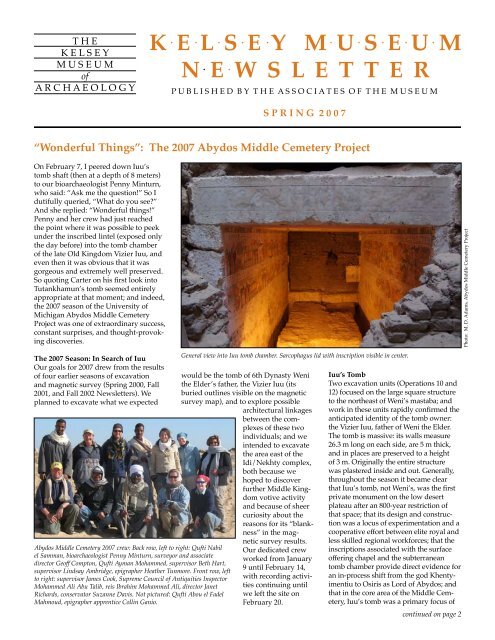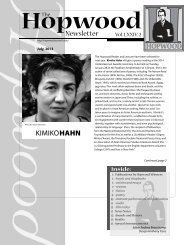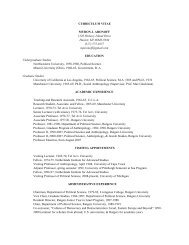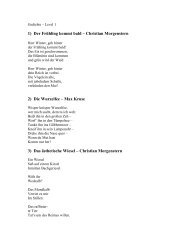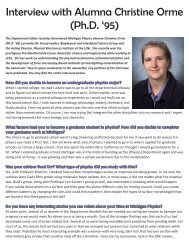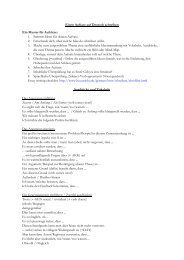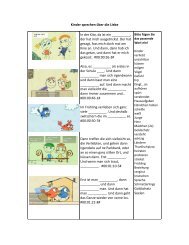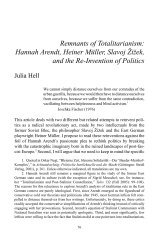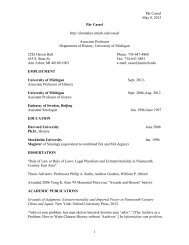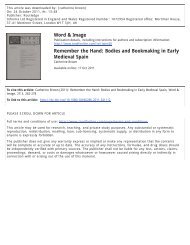K E L s E Y M U s E U M n E W s L E T T E r - College of Literature ...
K E L s E Y M U s E U M n E W s L E T T E r - College of Literature ...
K E L s E Y M U s E U M n E W s L E T T E r - College of Literature ...
You also want an ePaper? Increase the reach of your titles
YUMPU automatically turns print PDFs into web optimized ePapers that Google loves.
T H E<br />
K E L S E Y<br />
M U S E U M<br />
<strong>of</strong><br />
A R C H A E O L O G Y<br />
K E L s E Y M U s E U M<br />
n E W s L E T T E r<br />
P U B L I S H E D B Y T H E A S S O C I A T E S O F T H E M U S E U M<br />
s p r i n g 2 0 0 7<br />
“Wonderful Things”: The 2007 Abydos Middle Cemetery project<br />
On February 7, I peered down Iuu’s<br />
tomb shaft (then at a depth <strong>of</strong> 8 meters)<br />
to our bioarchaeologist Penny Minturn,<br />
who said: “Ask me the question!” So I<br />
dutifully queried, “What do you see?”<br />
And she replied: “Wonderful things!”<br />
Penny and her crew had just reached<br />
the point where it was possible to peek<br />
under the inscribed lintel (exposed only<br />
the day before) into the tomb chamber<br />
<strong>of</strong> the late Old Kingdom Vizier Iuu, and<br />
even then it was obvious that it was<br />
gorgeous and extremely well preserved.<br />
So quoting Carter on his first look into<br />
Tutankhamun’s tomb seemed entirely<br />
appropriate at that moment; and indeed,<br />
the 2007 season <strong>of</strong> the University <strong>of</strong><br />
Michigan Abydos Middle Cemetery<br />
Project was one <strong>of</strong> extraordinary success,<br />
constant surprises, and thought-provoking<br />
discoveries.<br />
The 2007 season: in search <strong>of</strong> iuu<br />
Our goals for 2007 drew from the results<br />
<strong>of</strong> four earlier seasons <strong>of</strong> excavation<br />
and magnetic survey (Spring 2000, Fall<br />
2001, and Fall 2002 Newsletters). We<br />
planned to excavate what we expected<br />
Abydos Middle Cemetery 2007 crew: Back row, left to right: Qufti Nabil<br />
el Samman, bioarchaeologist Penny Minturn, surveyor and associate<br />
director Ge<strong>of</strong>f Compton, Qufti Ayman Mohammed, supervisor Beth Hart,<br />
supervisor Lindsay Ambridge, epigrapher Heather Tunmore. Front row, left<br />
to right: supervisor James Cook, Supreme Council <strong>of</strong> Antiquities Inspector<br />
Mohammed Ali Abu Talib, reis Ibrahim Mohammed Ali, director Janet<br />
Richards, conservator Suzanne Davis. Not pictured: Qufti Abou el Fadel<br />
Mahmoud, epigrapher apprentice Collin Ganio.<br />
General view into Iuu tomb chamber. Sarcophagus lid with inscription visible in center.<br />
would be the tomb <strong>of</strong> 6th Dynasty Weni<br />
the Elder’s father, the Vizier Iuu (its<br />
buried outlines visible on the magnetic<br />
survey map), and to explore possible<br />
architectural linkages<br />
between the complexes<br />
<strong>of</strong> these two<br />
individuals; and we<br />
intended to excavate<br />
the area east <strong>of</strong> the<br />
Idi/Nekhty complex,<br />
both because we<br />
hoped to discover<br />
further Middle Kingdom<br />
votive activity<br />
and because <strong>of</strong> sheer<br />
curiosity about the<br />
reasons for its “blankness”<br />
in the mag-<br />
netic survey results.<br />
Our dedicated crew<br />
worked from January<br />
9 until February 14,<br />
with recording activities<br />
continuing until<br />
we left the site on<br />
February 20.<br />
iuu’s Tomb<br />
Two excavation units (Operations 10 and<br />
12) focused on the large square structure<br />
to the northeast <strong>of</strong> Weni’s mastaba; and<br />
work in these units rapidly confirmed the<br />
anticipated identity <strong>of</strong> the tomb owner:<br />
the Vizier Iuu, father <strong>of</strong> Weni the Elder.<br />
The tomb is massive: its walls measure<br />
26.3 m long on each side, are 5 m thick,<br />
and in places are preserved to a height<br />
<strong>of</strong> 3 m. Originally the entire structure<br />
was plastered inside and out. Generally,<br />
throughout the season it became clear<br />
that Iuu’s tomb, not Weni’s, was the first<br />
private monument on the low desert<br />
plateau after an 800-year restriction <strong>of</strong><br />
that space; that its design and construction<br />
was a locus <strong>of</strong> experimentation and a<br />
cooperative effort between elite royal and<br />
less skilled regional workforces; that the<br />
inscriptions associated with the surface<br />
<strong>of</strong>fering chapel and the subterranean<br />
tomb chamber provide direct evidence for<br />
an in-process shift from the god Khentyimentiu<br />
to Osiris as Lord <strong>of</strong> Abydos; and<br />
that in the core area <strong>of</strong> the Middle Cemetery,<br />
Iuu’s tomb was a primary focus <strong>of</strong><br />
continued on page 2<br />
Photo: M. D. Adams, Abydos Middle Cemetery Project
Photo: J. Cook, Abydos Middle Cemetery Project<br />
2 spring 2007<br />
notes from the Director<br />
Those <strong>of</strong> you who have passed by the Kelsey Museum in recent months will have<br />
noticed that work has at last begun on the long-anticipated William E. Upjohn Exhibit<br />
Hall. Site preparation started in late December, and as I write today, the floor <strong>of</strong><br />
the first-floor exhibit hall is being poured. You can see pictures <strong>of</strong> the progress from<br />
groundbreaking to basement layout on page 5. We are at this time two weeks ahead <strong>of</strong><br />
schedule and hope to maintain that pace, weather permitting. Our staff continue to be<br />
busy with preparations for the move and reinstallation <strong>of</strong> the collections, and curators<br />
are finalizing their choices for the new displays. This is hard work. Even with tripled<br />
gallery space it is still a matter <strong>of</strong> “so many wonderful things, so little space.”<br />
As you can see from the articles in this newsletter, research, teaching, and exhibit<br />
activities continue both inside and outside the current building. We were particularly<br />
pleased to participate in the Turin exhibition, “Alexander’s Heirs in Asia: From Seleucia<br />
to Ghandāra.” Our materials represented the largest group <strong>of</strong> loaned artifacts. We<br />
were in illustrious company with other loans from the Metropolitan Museum in New<br />
York and the Louvre. Janet Richards’s excavations at Abydos this winter produced<br />
amazing finds, which were the focus <strong>of</strong> this spring’s Associates event. You can read<br />
more about them on pages 1–4. Thanks to an incentive grant from the Archaeological<br />
Institute <strong>of</strong> America, Todd Gerring was able to put together an innovative program to<br />
teach local schoolchildren about archaeology through our collections (story on page<br />
8). The fruits <strong>of</strong> their labors will be on display from May 11 to May 25. Please do come<br />
by to see them. And be sure to visit the galleries if you can this summer. We will be<br />
closing them to the public as <strong>of</strong> August 15, so this will be your last chance to see your<br />
favorite pieces until we reopen in the Upjohn wing in 2009.<br />
In preparation for writing these notes I was looking over my comments in the Fall<br />
Newsletter. I was struck by the photograph <strong>of</strong> Ed Meader happily wielding a shovel<br />
in last May’s ceremonial groundbreaking. It is with pr<strong>of</strong>ound regret that I tell you<br />
Ed passed away this winter. We have been truly blessed by his and Mary Meader’s<br />
extraordinary generosity. Those <strong>of</strong> us who were lucky enough to know Ed will miss<br />
his wonderful stories <strong>of</strong> the early days <strong>of</strong> the Kelsey and how he came to love the<br />
collections, as well as his unflagging support and advice. We know we will have him<br />
with us in spirit in our grand reopening.<br />
Sharon Herbert, Director<br />
continued from page 1<br />
veneration in later periods. These insights<br />
emerged from excavation results in both<br />
interior and exterior contexts <strong>of</strong> Iuu’s<br />
mastaba as well as the spatial<br />
relationships between<br />
this tomb and contemporary<br />
and later structures in the<br />
cemetery.<br />
Iuu’s tomb from the north. On the left, view to chapel on eastern face and remains <strong>of</strong> false<br />
door in situ. On the right, view into mastaba interior, with safety structure over the shaft<br />
visible in center, and vaulted serdab in southern wall.<br />
James Cook and Heather Tunmore<br />
excavated most <strong>of</strong> the length <strong>of</strong> the east<br />
exterior wall <strong>of</strong> Iuu’s mastaba, including<br />
his <strong>of</strong>fering chapel and a complex <strong>of</strong><br />
later buildings and burials radiating out<br />
to the east, south, and north <strong>of</strong> the mastaba.<br />
Already in the first week <strong>of</strong> excavation,<br />
indications <strong>of</strong> the chapel walltops<br />
emerged, along with the uppermost<br />
part <strong>of</strong> a broken hieroglyphic inscription<br />
on limestone. The chapel was simply<br />
built and mostly undecorated, but that<br />
limestone fragment was only part <strong>of</strong> the<br />
lower half <strong>of</strong> an immense false door, 2 m<br />
wide and still in situ in the chapel. (The<br />
upper half was apparently removed by<br />
excavators in the nineteenth century,<br />
and its whereabouts are unknown.) The<br />
door was produced in two pieces, which<br />
were then put in place side by side and<br />
plastered down the join. The preserved<br />
portion bears eight beautifully rendered<br />
representations <strong>of</strong> the Vizier Iuu receiving<br />
<strong>of</strong>ferings from various relatives,<br />
including Weni the Elder. A band <strong>of</strong><br />
decoration at the very bottom <strong>of</strong> the door<br />
depicts another series <strong>of</strong> smaller figures,<br />
presumably either more relatives (perhaps<br />
grandchildren) or persons associated<br />
with Iuu’s estate. This massive piece<br />
<strong>of</strong> chapel furniture was clearly produced<br />
in a royal workshop; but based on variations<br />
in style and execution, epigrapher<br />
Heather Tunmore believes that the two<br />
halves <strong>of</strong> the false door were produced<br />
Map <strong>of</strong> 2007 work shown in relation to prior excavation seasons.<br />
Map: G. Compton
Photo: S. Davis<br />
spring 2007<br />
Epigraphy in action: Heather Tunmore and Collin Ganio.<br />
by different artists. A badly worn <strong>of</strong>fering<br />
table on the chapel floor in front <strong>of</strong><br />
the false door reflects the persistence <strong>of</strong><br />
Iuu’s mortuary cult through succeeding<br />
generations.<br />
Inside the mastaba, Penny Minturn<br />
and Beth Hart excavated the tomb shaft<br />
and chamber as well as a serdab feature<br />
built into the south wall, and a small<br />
makeshift mudbrick structure in the interior<br />
southeast corner that originally held<br />
leftover mummification materials. The<br />
Iuu mastaba was previously documented<br />
by Lepsius during his 1837 visit to<br />
Abydos; remains <strong>of</strong> his excavation ramp<br />
were still in evidence, descending down<br />
the interior face <strong>of</strong> the mastaba south<br />
wall, passing the serdab (where conservator<br />
Suzanne Davis supervised the<br />
excavation <strong>of</strong> a fragmentary life-sized<br />
decayed wooden ka statue) and turning<br />
toward the mouth <strong>of</strong> the tomb shaft. This<br />
shaft was <strong>of</strong> mudbrick and extremely<br />
deep; so, as with our 2001 excavations <strong>of</strong><br />
the Weni shaft, we erected a safety structure,<br />
wore hard hats, and used climbing<br />
gear and rope when scaling the ladder.<br />
“Wonderful things” was indeed an apt<br />
description <strong>of</strong> the tomb chamber. Our<br />
excavations descended nearly 10 m, past<br />
a mudbrick vault surmounting a stone<br />
slab ro<strong>of</strong> and lintel inscribed for Iuu.<br />
Much <strong>of</strong> the mudbrick wall that originally<br />
blocked the entrance to the stone chamber<br />
remained intact, probably a positive<br />
factor in its preservation; and unlike his<br />
son Weni’s chamber, Iuu’s eternal resting<br />
place had not been burned. The chamber<br />
was 4.2 m long by 2 m wide, and its<br />
brightly painted low relief decorative<br />
scheme was beautifully preserved, with<br />
representations <strong>of</strong> <strong>of</strong>ferings, false doors,<br />
a menu list, granaries, and choice cuts <strong>of</strong><br />
meat, punctuated by bands <strong>of</strong> inscriptions<br />
painted in blue. Much to our surprise,<br />
we discovered that Lepsius had removed<br />
most <strong>of</strong> the north wall <strong>of</strong> the chamber<br />
(its whereabouts are unknown); he also<br />
seems to have extracted all grave goods<br />
from the chamber during his visit. The<br />
huge limestone sarcophagus remained<br />
in situ, however; broken open by thieves<br />
and/or Lepsius, it bore inscriptions inside<br />
and out, invoking Osiris Khenty-imentiu<br />
as the Lord <strong>of</strong> Abydos, while elsewhere in<br />
the chamber inscriptions this god appears<br />
only as Osiris. These variations were a<br />
reminder that the ascendancy <strong>of</strong> Osiris<br />
as Lord <strong>of</strong> Abydos was just beginning<br />
around the time <strong>of</strong> the construction <strong>of</strong><br />
Iuu’s tomb, with more consistency in<br />
inscriptions seen just one generation later<br />
in Weni’s burial chamber.<br />
One poignant find did emerge from<br />
the sarcophagus: Several pieces <strong>of</strong> the<br />
skull and face <strong>of</strong> a human male in his<br />
40s, which may well be all that is left <strong>of</strong><br />
Iuu himself, serve as a reminder <strong>of</strong> lower<br />
life expectancies in the ancient world,<br />
even for elite individuals.<br />
Votive Activity in the<br />
First intermediate period<br />
During these explorations <strong>of</strong> the Iuu<br />
mastaba, Ge<strong>of</strong>f Compton and Lindsay<br />
Ambridge supervised excavations in<br />
the “blank” area to the east <strong>of</strong> the Idi/<br />
Nekhty mastaba complex (Operation 13).<br />
False door detail with Weni the Elder <strong>of</strong>fering staves <strong>of</strong> authority<br />
to his father Iuu.<br />
Far from being featureless as implied by<br />
the magnetic survey data, this area yielded<br />
a mass <strong>of</strong> <strong>of</strong>ten unexpected facts about<br />
the nature <strong>of</strong> spatial patterning in and<br />
diachronic use <strong>of</strong> the cemetery as well as<br />
the natural topography <strong>of</strong> the hill, now<br />
revealed to drop sharply <strong>of</strong>f to the east.<br />
Ge<strong>of</strong>f and Lindsay were able to define a<br />
ten-part stratigraphic sequence over two<br />
millennia, between the original late Old<br />
Kingdom establishment <strong>of</strong> the cemetery,<br />
through an intensive period <strong>of</strong> use in the<br />
First Intermediate Period and some activity<br />
in the Middle Kingdom, followed by<br />
a long period <strong>of</strong> abandonment, and then<br />
reuse during the Saite period.<br />
View down Iuu tomb shaft to lintel.<br />
continued on page 4<br />
Photo: Abydos Middle Cemetery Project<br />
Photo: Abydos Middle Cemetery Project
Photo: Abydos Middle Cemetery Project<br />
Photo: Abydos Middle Cemetery Project<br />
Stela <strong>of</strong> Gerhi in makeshift niche on exterior <strong>of</strong> Idi/Nekhty enclosure wall.<br />
Overall view towards: Weni northeast corner, subsidiary mastaba, and Iuu<br />
southwest corner with empty niche.<br />
During their work in this area, they<br />
excavated a small First Intermediate<br />
Period chapel, tucked into the exterior<br />
<strong>of</strong> the enclosure wall <strong>of</strong> the Idi/Nekhty<br />
mastaba and still containing the crudely<br />
carved votive stela placed there more<br />
than four thousand years ago. Inscribed<br />
for a lector priest named Gerhi, it also<br />
commemorates a man named Idi—perhaps<br />
a descendant <strong>of</strong> the Old Kingdom<br />
ancestor originally buried in the large<br />
tomb complex where it was dedicated.<br />
If this is indeed a votive as opposed to<br />
funerary stela, it is the first such evidence<br />
for activity <strong>of</strong> this kind during this<br />
period in the Middle Cemetery.<br />
One last bit <strong>of</strong> information this area<br />
provided: correction factors for the<br />
magnetic survey data. The failure <strong>of</strong> that<br />
technique to map these archaeological<br />
remains—3 m below the rubble piles<br />
left by Mariette’s excavations 150 years<br />
ago—has demonstrated<br />
the depth<br />
at which a stronger<br />
magnetic signature<br />
is required for effectiveness.<br />
This may<br />
help us to adjust for<br />
“noise” in future<br />
analyses <strong>of</strong> such<br />
data.<br />
iuu and Weni<br />
In the last week<br />
<strong>of</strong> the season, we<br />
opened a final unit<br />
in the area between<br />
the southwest<br />
corner <strong>of</strong> the Iuu<br />
mastaba and the<br />
northeast corner<br />
<strong>of</strong> Weni’s tomb, in<br />
order to determine<br />
whether there was<br />
any architectural<br />
linkage between the<br />
two. We also wished<br />
to see whether we<br />
could identify the<br />
original emplacement<br />
<strong>of</strong> the Iuu<br />
pillar excavated in<br />
1999, lying fallen<br />
in fill at the edge <strong>of</strong><br />
this new operation.<br />
Work to the east had<br />
uncovered a rough<br />
limestone base for<br />
such a pillar set into<br />
the southeast corner<br />
<strong>of</strong> Iuu’s mastaba,<br />
with some small<br />
fragments <strong>of</strong> relief fallen to the side. It<br />
was therefore not unexpected when Ge<strong>of</strong>f<br />
and Lindsay also found a similar limestone<br />
base set in Iuu’s southwest corner,<br />
resolving the question <strong>of</strong> the ancient<br />
emplacement <strong>of</strong> our Iuu pillar.<br />
What did startle us was the emergence<br />
<strong>of</strong> a large rectangular mastaba perpendicular<br />
to the west <strong>of</strong> Iuu’s mastaba where<br />
we had expected to see only a wall connecting<br />
his tomb to his son’s, based on the<br />
magnetometric map. This surprise was<br />
followed in quick succession by the find<br />
<strong>of</strong> a pillar emplacement surrounded by a<br />
small courtyard on the northeast corner<br />
<strong>of</strong> the Weni mastaba, with the lower third<br />
<strong>of</strong> a pillar inscribed for him still in place<br />
and large fragments <strong>of</strong> the rest scattered<br />
around it. Weni therefore echoed design<br />
elements <strong>of</strong> his father’s tomb architecture<br />
a generation later, as he carefully situated<br />
his mastaba respectfully behind and near-<br />
spring 2007<br />
ly a meter lower than Iuu’s grave—another<br />
surprise, since we had come to think <strong>of</strong><br />
Weni’s grave as lying on the highest part<br />
<strong>of</strong> the Middle Cemetery hill.<br />
Analysis <strong>of</strong> our rich harvest <strong>of</strong> data<br />
from this season has barely begun but<br />
has already demonstrated that there is<br />
still much to learn from archaeology in<br />
the Middle Cemetery.<br />
Janet Richards<br />
We are grateful to Mr. Zein Abdin Zaki and<br />
Miss Aziza el-Sayed Hassan for their support;<br />
as well as to Dr. Zahi Hawass and the Permanent<br />
Committee <strong>of</strong> the Supreme Council <strong>of</strong><br />
Antiquities, Egypt, for permission to conduct<br />
the work. Finally, we must thank manager<br />
Ahmed Rageb, Hassan Mitwalli, Mustafa<br />
Hanafi, Sinjab Abdul Rahman, Lashiin<br />
Ahmed, Awad Mohammed, and Zacaria<br />
Abdul Noor at the Abydos dig house; and our<br />
colleague Matthew D. Adams, Field Director<br />
<strong>of</strong> the Institute <strong>of</strong> Fine Arts/New York University<br />
project, for all <strong>of</strong> his help throughout the<br />
season.<br />
Project funding was provided by the U-<br />
M’s Kelsey Museum <strong>of</strong> Archaeology, Office<br />
<strong>of</strong> the Vice Provost for Research, <strong>College</strong> <strong>of</strong><br />
<strong>Literature</strong>, Science, and the Arts, Horace H.<br />
Rackham School <strong>of</strong> Graduate Studies, and<br />
Department <strong>of</strong> Near Eastern Studies, as well<br />
as Marjorie M. Fisher and an anonymous donor.<br />
The season would not have been possible<br />
without the support <strong>of</strong> Kelsey Director Sharon<br />
Herbert and Near Eastern Studies Chair Gary<br />
Beckman, and the hard work <strong>of</strong> Kelsey front<br />
<strong>of</strong>fice staff Helen Baker, Sandra Malveaux,<br />
Jackie Monk, and Alex Zwinak, and <strong>of</strong> Kelsey<br />
Graduate Student Research Assistant Diana<br />
Ng. Thanks also to Richard Parkinson and<br />
Detlef Franke for their opinions on the date<br />
and names <strong>of</strong> the Gerhi stela, and to Terry<br />
Wilfong for assistance with the interpretation<br />
<strong>of</strong> inscriptions as they emerged in this<br />
season’s work.<br />
Lower portion <strong>of</strong> Weni pillar still in situ on<br />
northeast corner <strong>of</strong> his mastaba.<br />
Photo: Abydos Middle Cemetery Project
Photo: S. Encina<br />
Photo: S. Encina<br />
Photo: S. Encina<br />
spring 2007<br />
Construction in progress on the Museum’s new Upjohn Wing<br />
1. Mass excavation <strong>of</strong> the Kelsey Museum’s former parking lot.<br />
3. Basement wall forms in place and finished walls as viewed from the LS&A<br />
building next door.<br />
2. Earth retention installation and forms being placed for basement concrete<br />
wall pours.<br />
4. Finished basement with underslab waterpro<strong>of</strong>ing in place prior to having<br />
the basement floor poured.<br />
5. Workers leveling the basement floor. 6. Our first look at the corridor in the basement!<br />
Photo: S. Encina Photo: S. Encina Photo: S. Encina
Photo: C. Chemello<br />
The Traveling Conservator: Tales from Turin<br />
In 2005, the Kelsey was approached to<br />
loan archaeological objects from its extensive<br />
holdings <strong>of</strong> material<br />
from Seleucia (mod-<br />
Spotlight<br />
ern-day Iraq) to the<br />
Museo Civico d’Arte<br />
Antica di Torino (the<br />
Civic Museum <strong>of</strong> Turin)<br />
for a major exhibition entitled “Sulla via<br />
di Alessandro: Da Seleucia al Ghandāra”<br />
(Alexander’s Heirs in Asia: From Seleucia<br />
to Ghandāra). The exhibition, which<br />
is currently on display at the recently<br />
restored Palazzo Madama, Turin, is also<br />
the inaugural show for the beautiful Sala<br />
del Senato (Senate Hall) <strong>of</strong> the Palazzo.<br />
The exhibition highlights the work <strong>of</strong> the<br />
Italian mission in Seleucia, particularly<br />
the work <strong>of</strong> Pr<strong>of</strong>essor Antonio Invernizzi,<br />
Scientific Director <strong>of</strong> the Turin Center for<br />
Archaeological Research in the Middle<br />
East and Asia, under whose auspices the<br />
Italian Archaeological Expedition in Iraq<br />
began excavations at Seleucia-on-the-Tigris<br />
in 1964.<br />
Among their many other duties,<br />
Kelsey conservators are responsible for<br />
objects that go out on loan, from a single<br />
item to a complete touring exhibition. It<br />
is standard practice for a representative<br />
<strong>of</strong> the Museum to act as courier, traveling<br />
with the loaned objects between locations.<br />
The courier is responsible for the<br />
safety <strong>of</strong> the objects during all stages <strong>of</strong><br />
transport between venues, supervising<br />
the packing, unpacking, and installation<br />
(or deinstallation) and checking the objects<br />
against condition reports provided<br />
by Kelsey conservators. In addition to<br />
undertaking conservation work on the<br />
38 objects selected for the exhibition, I<br />
was also the courier who accompanied<br />
the crated objects to Turin.<br />
When objects are loaned to another<br />
institution, and especially if they travel<br />
internationally, a complex set <strong>of</strong> issues<br />
needs to be taken into consideration. The<br />
conservation department, in conjunction<br />
with a representative from the Turin<br />
Center for Archaeological Research in<br />
the Middle East and Asia, assessed the<br />
initial list <strong>of</strong> 51 objects requested for loan<br />
to determine whether the objects were<br />
stable and robust enough for travel. The<br />
borrower then pared this list back to 38<br />
objects, and I was able to begin treating<br />
the material in preparation for travel. The<br />
objects requested for loan consisted <strong>of</strong><br />
seventeen small and one large terracotta<br />
figurines, one larger stone figurine, one<br />
stucco architectural fragment, three cuneiform<br />
tablets, fourteen ceramic vessels,<br />
and a small bronze mirror. A couple <strong>of</strong><br />
the objects had undergone prior conservation<br />
treatment, but most had not been<br />
assessed by a conservator since they<br />
were received at the Kelsey in the 1920s<br />
and 1930s. Most <strong>of</strong> the objects chosen for<br />
travel had never been displayed before.<br />
Conservation <strong>of</strong> the objects included<br />
digital photographic as well as detailed<br />
written documentation <strong>of</strong> their condition.<br />
Treatment <strong>of</strong> the material consisted<br />
<strong>of</strong> removing layers <strong>of</strong> dust and dirt, particularly<br />
well accumulated on some <strong>of</strong><br />
the ceramics; reversing old, inaccurate,<br />
yellowed restorations and rejoining with<br />
a synthetic, reversible adhesive with<br />
The crate <strong>of</strong> Kelsey Museum objects waiting to be loaded onto the plane. The Palazzo Madama, Turin, Italy.<br />
spring 2007<br />
good ageing properties; consolidating<br />
fragile surface areas; removing insoluble<br />
salts where visually distracting; removing<br />
distracting, waxy red pencil from<br />
some <strong>of</strong> the terracotta figurines (most<br />
likely acquired in the field during initial<br />
excavation and recording); removing<br />
old, abrasive mounts and replacing them<br />
with less damaging ones appropriate for<br />
the material type.<br />
Once conservation treatment was<br />
complete, specific handling and packing<br />
requirements were discussed with Paul<br />
Smith, an art packer who has worked<br />
with the Museum to crate numerous<br />
loans for travel both within the United<br />
States and internationally. The 38 objects<br />
were packed into a large, custom-built<br />
wooden crate for transport, with individual<br />
recessed areas cut into thick foam<br />
planks to house the ceramics and large<br />
figurines and a rigid box support with<br />
individually padded compartments for<br />
the smaller objects.<br />
The crates were transported between<br />
the Kelsey Museum and Turin by both<br />
road and air. The most direct flight to the<br />
destination is favored for transporting<br />
fragile cultural material, as loading and<br />
unloading crates for several flights is too<br />
risky. For this loan, the most direct flight<br />
to Italy was from Chicago to Milan. The<br />
crate was transported to Chicago on<br />
a truck equipped with air suspension<br />
and then hand-loaded onto a pallet at<br />
the Alitalia cargo center prior to being<br />
loaded into the cargo hold <strong>of</strong> the plane.<br />
Space is <strong>of</strong>ten tight in the cargo hold<br />
<strong>of</strong> a plane, and it can be impossible to<br />
avoid stacking crates when palletizing.<br />
As I had an intimate knowledge <strong>of</strong> the<br />
crate construction and packing methods<br />
Photo: C. Chemello
Photo: C. Chemello<br />
spring 2007<br />
for the Kelsey objects, I felt confident in<br />
deciding which way our crate could be<br />
loaded and oriented. In this case, our objects<br />
were accompanied by several crates<br />
<strong>of</strong> paintings from the Detroit Institute <strong>of</strong><br />
Arts, the Toledo Museum <strong>of</strong> Art, and the<br />
Flint Institute <strong>of</strong> Arts that were on their<br />
way to an exhibition in Florence.<br />
Once on the ground in Milan, I was<br />
met by our local contact, an agent from<br />
Gondrand International, an Italian<br />
art-handling and transport company. A<br />
four-hour wait for customs clearance for<br />
our crate from Rome meant that I was<br />
able to see close up the workings <strong>of</strong> the<br />
huge Alitalia freight center at Malpensa<br />
International Airport and taste the wonderful<br />
food in the airport staff cafeteria!<br />
Once cleared by Italian customs, the<br />
crate was again loaded and secured onto<br />
a truck for the road journey to Turin,<br />
which took about two hours. This drive<br />
took us past some lovely views <strong>of</strong> the<br />
Alps, but unfortunately I could only get<br />
glimpses <strong>of</strong> the snow-capped mountains<br />
through the low clouds and smog that<br />
are so familiar to the Po river valley<br />
region <strong>of</strong> northern Italy.<br />
Our crate was taken directly to the<br />
Palazzo Madama, which is located in the<br />
city center, where it was to remain for<br />
twenty-four hours to acclimate to local<br />
environmental conditions before being<br />
opened. Once the crate was opened,<br />
I unpacked and checked each object<br />
individually against its pre-travel condition<br />
report and photograph. With the<br />
assistance <strong>of</strong> the exhibit preparators and<br />
designers for this exhibition, a combination<br />
<strong>of</strong> staff from the Civic Museum <strong>of</strong><br />
Turin and contracted museum specialists,<br />
each object was then installed safely<br />
into its showcase. Individual mounting<br />
systems for some <strong>of</strong> the objects were<br />
designed and constructed on the spot;<br />
these consisted <strong>of</strong> silicon-covered pins<br />
and rods to which plastic wire was tied<br />
to secure the objects without damaging<br />
their surface or being obtrusive, as well<br />
as barrier layers between the object and<br />
the painted surface <strong>of</strong> the showcase.<br />
This exhibition borrows material from<br />
numerous cultural institutions worldwide,<br />
and the installation team was<br />
kept on their toes with different couriers<br />
arriving each day with diverse installation<br />
requirements varying in complexity.<br />
Thankfully, the Sala del Senato<br />
(Senate Hall), which houses temporary<br />
exhibits in the Palazzo Madama, is on<br />
the same floor as the very stylish café,<br />
where good, strong Italian c<strong>of</strong>fee and<br />
panini could be had at any time during<br />
the day! The café also has a wonderful<br />
view <strong>of</strong> the Piazza Castello, where the<br />
Palazzo is located, through floor-to-ceiling<br />
windows.<br />
Turin is a city renowned for its many<br />
museums, encompassing subjects ranging<br />
from archaeological materials to<br />
history and natural history, ethnography,<br />
science and technology, and modern art.<br />
There are also many specialist museums<br />
devoted to topics such as cinema, automobiles,<br />
and even a marionette museum.<br />
I was able to visit the Museo Egizio, the<br />
Egyptian Museum, which is said to have<br />
the largest and most important collection<br />
<strong>of</strong> Egyptian artifacts outside <strong>of</strong> Cairo.<br />
Evidently Jean-François Champollion,<br />
the renowned decipherer <strong>of</strong> Egyptian hieroglyphs,<br />
famously wrote, “The road to<br />
Memphis and Thebes passes through Turin.”<br />
This museum, founded in 1824 and<br />
housed in a beautiful seventeenth-century<br />
palace, is justifiably popular, with<br />
6,500 objects on display. One <strong>of</strong> the most<br />
imposing galleries <strong>of</strong> the museum is the<br />
Statuario, a dramatic gallery dedicated<br />
to monumental stone sculpture representing<br />
a veritable royal Who’s Who <strong>of</strong><br />
the kings and gods <strong>of</strong> ancient Egypt. The<br />
gallery lighting was an amazing backdrop<br />
to the sculptures; it was designed<br />
by Dante Ferretti, the Oscar-winning art<br />
director <strong>of</strong> The Aviator, and was installed<br />
during the first half <strong>of</strong> 2006.<br />
I encourage all those who find themselves<br />
in Italy before May 27 (the closing<br />
date for the exhibition) to take a look at<br />
this incredible exhibition. The Palazzo<br />
Madama is an unforgettable venue in<br />
which to display the objects from our<br />
own Kelsey collection to the world. Since<br />
1934 the Palazzo has housed the collections<br />
<strong>of</strong> the Civic Museum <strong>of</strong> Turin, a<br />
wide-ranging assemblage <strong>of</strong> 30,000 objects,<br />
including paintings, archaeological<br />
material, sculpture, textiles, and decorative<br />
arts. The Palazzo itself was initially<br />
one <strong>of</strong> the entrance gates to the Roman<br />
city Augusta Taurinorum on the decuman<br />
maximum (east-west axis—today the Via<br />
Garibaldi). Among its other manifestations,<br />
the Palazzo has experienced life<br />
as a fortress in the medieval period, a<br />
castle in the 1400s, and a baroque royal<br />
palace for the royal madames, Christine<br />
<strong>of</strong> France and Maria Giovanna Battista<br />
<strong>of</strong> Savoy Nemours, during which time<br />
it took the name Palazzo Madama. The<br />
restoration <strong>of</strong> the Palazzo, itself a longawaited<br />
multiyear effort, has enabled the<br />
incredible history <strong>of</strong> the building to be<br />
appreciated in all its guises.<br />
Claudia Chemello<br />
Some <strong>of</strong> the Kelsey’s ceramics newly installed in their showcase for the exhibition. Some <strong>of</strong> the Kelsey’s small terracotta figurines being installed for the exhibition.<br />
7<br />
Photo: C. Chemello
Photo: T. Gerring<br />
Kelsey’s Public Programs Office Wins AIA Local Society Incentive Grant<br />
As part <strong>of</strong> their participation in the AIA Incentive Grant Program, Greenhills School students (clockwise<br />
from left) Neeli Amin, Christine Bizgu, Kate Hill, Drew Goldsworthy, and Tom McClure discuss a group<br />
<strong>of</strong> toys from the “grave goods” activity.<br />
Each year the Archaeological Institute<br />
<strong>of</strong> America (AIA) Local Society Incentive<br />
Grant provides $1,500 to one local<br />
society for archaeology projects focusing<br />
on public outreach and education. In<br />
collaboration with the Kelsey Museum<br />
Public Programs Office, the Ann Arbor<br />
Chapter <strong>of</strong> the AIA submitted the winning<br />
proposal and received the 2006 Local<br />
Society Incentive Grant. The program<br />
was designed to teach K-12 students<br />
about archaeology through a variety <strong>of</strong><br />
workshops and activities, resulting in a<br />
public exhibition <strong>of</strong> their work.<br />
The first step in the program was the<br />
creation <strong>of</strong> an archaeology kit, similar<br />
to the Kelsey’s Civilization-in-a-Crate<br />
program, including various teaching<br />
resources such as books, videos, and<br />
artifact reproductions. After the kit had<br />
been created, I invited a number <strong>of</strong><br />
schools and organizations to participate<br />
in the program. Five groups accepted<br />
the invitation, for a total <strong>of</strong> sixty-five<br />
participants ranging from fourth to ninth<br />
grades. The five groups include Greenhills<br />
School, SAGE Homeschool, Girl<br />
Scouts Cadette Troop 1336 <strong>of</strong> the Huron<br />
Valley Council, and two classes from the<br />
Academy <strong>of</strong> the Sacred Heart in Bloomfield<br />
Hills.<br />
Once the groups were on board, the<br />
second step <strong>of</strong> the program began. I<br />
planned activities to stimulate discussion<br />
about archaeology and the problems<br />
faced by modern archaeologists.<br />
The grave goods activity presented the<br />
students with three groups <strong>of</strong> artifacts<br />
from individual graves. The students<br />
were divided into teams and assigned<br />
the task <strong>of</strong> determining who might have<br />
been buried with each group <strong>of</strong> objects.<br />
They had to determine age, sex, state <strong>of</strong><br />
health, and social status based on the<br />
objects alone. There was a minor setback<br />
when an oil lamp was mistakenly identified<br />
as a teapot, and there was some<br />
confusion between a stylus and a<br />
hairpin. But as misidentification<br />
is as old as archaeology itself, our<br />
junior archaeologists were simply<br />
following in the footsteps <strong>of</strong> some<br />
illustrious scholars!<br />
No picture <strong>of</strong> modern archaeology<br />
could be complete without the realities<br />
<strong>of</strong> life on a dig. IPCAA graduate<br />
student Lorraine Knop set the<br />
record straight on dinosaurs, gold,<br />
and backfill. She also addressed the<br />
true dangers <strong>of</strong> archaeology—chiefly<br />
dogs, bulls, and falling buckets—by<br />
giving the participants a glimpse<br />
into life on excavations in Greece and<br />
Italy.<br />
Through the course <strong>of</strong> the program<br />
the students learned about<br />
spring 2007<br />
numerous archaeological methods, from<br />
excavations to carbon-14 dating. Once<br />
we established that dating methods applied<br />
to the age <strong>of</strong> objects and not to social<br />
relationships, they were introduced<br />
to additional archaeological mysteries,<br />
such as thermoluminesence, cocciopesto,<br />
and the all-important context.<br />
The final phase in the program was the<br />
creation <strong>of</strong> mini-exhibits by the students.<br />
Although all <strong>of</strong> the exhibits focus on the<br />
archaeology <strong>of</strong> the Mediterranean, each<br />
<strong>of</strong> the five groups chose a unique theme<br />
for its project, from Greek mythology and<br />
ancient art to writing and fashion. Besides<br />
choosing the reproductions used in the<br />
exhibit, some industrious student-curators<br />
decided to create their own “ancient<br />
artifacts,” modeled on actual antiquities.<br />
Perhaps they learned a trick or two from<br />
a presentation on fakes and forgeries<br />
within the Kelsey’s own collections.<br />
The final phase was possibly the most<br />
labor-intensive aspect <strong>of</strong> the whole<br />
project, as all students were required<br />
to research and write their own label<br />
copy. They also worked in groups to pen<br />
additional case labels, but perhaps the<br />
toughest task <strong>of</strong> all was picking a title for<br />
their exhibit.<br />
It has been a pleasure working with<br />
these students and watching their excitement<br />
and knowledge grow. I want to<br />
thank them, their teachers, troop leaders,<br />
parents, and schools for participating in<br />
this project.<br />
All five exhibits will be on display in<br />
the Kelsey exhibition “From Excavation<br />
to Education: Archaeology in the Classroom,”<br />
from May 11 to May 25.<br />
Todd Gerring<br />
Sara Olson (left) and Betsy Mansfield <strong>of</strong> the Emerson<br />
Cadette Girl Scout Troop 1336 create Sumerian jewelry for<br />
their exhibition on clothing and fashion in the ancient world.<br />
Photo: T. Gerring
spring 2007<br />
From the Archives: The John Henry parker Collection <strong>of</strong> Victorian photographs<br />
Among its many treasures the Kelsey<br />
Museum is fortunate to count the Parker<br />
Collection, some 3,300 nineteenth-century<br />
photographs <strong>of</strong> Roman monuments.<br />
The development <strong>of</strong> photography in<br />
the 1840s made it suddenly possible to<br />
document archaeological monuments,<br />
works <strong>of</strong> art, and artifacts in more detail<br />
and, in some cases, with more veracity<br />
than through drawings. By the 1860s the<br />
new medium was being widely used,<br />
particularly by John Henry Parker, one<br />
<strong>of</strong> the first scholars to understand the<br />
camera’s great potential for systematically<br />
recording Roman ruins. Many <strong>of</strong> the<br />
great and long-standing buildings <strong>of</strong> that<br />
city were increasingly subject to destruction<br />
by modernization, and Parker was<br />
strongly committed to creating a photographic<br />
record <strong>of</strong> classical and medieval<br />
architecture not only in Rome but<br />
throughout Italy. Although Parker rarely<br />
took the photographs himself, he commissioned<br />
specific views (and in some<br />
cases purchased existing negatives) from<br />
at least seven different photographers.<br />
John Henry Parker (1806–1884), son<br />
<strong>of</strong> a British merchant, entered into his<br />
uncle’s Oxford bookseller business in<br />
1821, at the age <strong>of</strong> fifteen, and a decade<br />
later assumed sole control <strong>of</strong> the firm. A<br />
highly successful businessman, he was<br />
also an outspoken advocate <strong>of</strong> restoration<br />
<strong>of</strong> ecclesiastical buildings and<br />
frequently published major works on<br />
Gothic architecture in England.<br />
In the 1870s, however, he turned his<br />
attention to the history <strong>of</strong> Rome, producing<br />
a number <strong>of</strong> exceptional books on<br />
Roman archaeology, topography, and<br />
architecture that today are recognized as<br />
classics (e.g., Archaeology <strong>of</strong> Rome, 1874–<br />
1883, and A Plan <strong>of</strong> Ancient Rome, 1878).<br />
His books were a labor <strong>of</strong> love, carefully<br />
recording and interpreting the history<br />
<strong>of</strong> “the Eternal City” through its early<br />
monuments. No architectural detail was<br />
too trivial, and each <strong>of</strong> his volumes is<br />
illustrated with abundant photo-engravings,<br />
plans, and elevations. Today his<br />
photographs provide not only minute<br />
details <strong>of</strong> the buildings, some no longer<br />
standing, but a window onto a critical<br />
period in the history <strong>of</strong> photography and<br />
the archaeology <strong>of</strong> Rome. In recognition<br />
<strong>of</strong> his efforts, Parker was decorated by<br />
the king <strong>of</strong> Italy and received a medal <strong>of</strong><br />
merit from Pope Pius IX.<br />
The Kelsey’s collection <strong>of</strong> Parker’s Roman<br />
photographs appears to be the only<br />
“almost complete” set <strong>of</strong> these images<br />
outside <strong>of</strong> Europe. They came to the<br />
Museum through the tireless efforts <strong>of</strong><br />
Francis W. Kelsey, the Museum’s founder.<br />
In July 1925, Pr<strong>of</strong>essor Kelsey noticed<br />
an advertisement for the sale <strong>of</strong> approximately<br />
3,300 <strong>of</strong> Parker’s photographs<br />
in Oxford, England. As a result <strong>of</strong> his<br />
typical and enthusiastic fundraising,<br />
Kelsey found the money to bring these<br />
photographs to Ann Arbor. Although it<br />
cannot be verified, it seems that the collection<br />
that Kelsey bought was Parker’s<br />
personal set, used for study purposes.<br />
Unfortunately Pr<strong>of</strong>essor Kelsey died<br />
in 1927, and twenty-two years passed<br />
before further mention <strong>of</strong> these photographs<br />
can be found in the University’s<br />
archives. They were then transferred<br />
from the U-M Library attic to the Kelsey<br />
attic. There, in 1979, they were rediscovered<br />
and now hold a special place in the<br />
collections <strong>of</strong> the Museum. They remain<br />
a precious record <strong>of</strong> nineteenth-century<br />
Rome as viewed through the eyes <strong>of</strong> a<br />
Victorian scholar.<br />
Lauren Talalay<br />
Based on the Kelsey catalogue A Victorian View <strong>of</strong><br />
Ancient Rome: The Parker Collection <strong>of</strong> Historical Photographs<br />
in the Kelsey Museum <strong>of</strong> Archaeology, by Judith<br />
Keller and Kenneth A. Breisch, with a foreword by<br />
Margaret C. Root (1980).<br />
Heroic nude torso <strong>of</strong> a type used by the Romans to<br />
represent a god, an athlete, or an emperor. Found in the<br />
Baths <strong>of</strong> Caracalla in Rome in 1868. Parker Collection<br />
1071.<br />
Marble statues and heads <strong>of</strong> Roman deities, portraits <strong>of</strong> statesmen, philosophers, an empress, and other<br />
Romans, excavated in Rome in 1874. Parker Collection 3212.
10 spring 2007<br />
Associates <strong>of</strong> the Kelsey Museum <strong>of</strong> Archaeology 200 –2007<br />
Benefactor<br />
Eugene and Emily Grant<br />
Mrs. Mary Meader and<br />
the late Edwin Meader<br />
George and Eathel Mendenhall<br />
Julie A. Sandler<br />
The Kelsey Museum Associates sponsor<br />
the Museum’s outreach and development<br />
activities and provide program<br />
support. The public is encouraged to<br />
join the Associates and participate in<br />
Museum activities. For more information<br />
call (734) 763-3559.<br />
patron<br />
Mr. and Mrs. David G. Richardson<br />
sponsor<br />
Herb and Carol Amster<br />
Pr<strong>of</strong>essor Lawrence Berlin<br />
Greg and Margene Henry<br />
Dr. Cyrus C. Hopkins<br />
Robert and Pearson Macek<br />
Bernice and Herman Merte<br />
Mr. and Mrs. Cruse W. Moss<br />
Zoe and Joe Pearson<br />
Mrs. Barbara Stieler Thompson<br />
Contributor<br />
Mr. and Mrs. John Beatty<br />
John and Leora Bowden<br />
Dr. and Mrs. Ethan Braunstein<br />
Pr<strong>of</strong>essor Charles Cares<br />
Carol and Ted Carzon<br />
Betts Chisholm<br />
Mr. and Mrs. William D. Coates<br />
Mr. and Mrs. Richard M. Cundiff<br />
Mrs. Susan Darrow<br />
Jane and Peter DeChants<br />
Tom and Jean Dickinson<br />
Lois Kuznets Dowling<br />
Pr<strong>of</strong>essor Ilene Forsyth<br />
Pr<strong>of</strong>essors Elaine Gazda<br />
and James McIntosh<br />
Esther M. Goudsmit<br />
Dr. James Harris<br />
Susan and Hayden Harris<br />
Lynn Hobbs<br />
Pr<strong>of</strong>essor Meredith Klaus<br />
Mary and Ed Krasny<br />
Marian Gram Laughlin<br />
John K. Lawrence<br />
Myron and Bobbie Levine<br />
Mr. Carl Lutkehaus<br />
Zelma and Milan Marich<br />
Mrs. Agnes Miner<br />
Kelly O’Donnell<br />
John and Mary Pedley<br />
Joseph G. and Sherry Roberts<br />
Amnon and Prudence Rosenthal<br />
Jane and Tom Schwenk<br />
Nancy G. Sippel<br />
Mr. and Mrs. Alfred Slote<br />
Haldon and Tina Smith<br />
Dr. Denny Stavros<br />
Len and Lois Stenger<br />
William J. Wolff<br />
Dual/Family<br />
Diana Bowman<br />
D. G. and P. M. Cameron<br />
Guy and Phyllis Coykendall<br />
David and Carole Darr<br />
Monte and Kris Del Monte<br />
Alice Fishman and Michael DiPietro<br />
Don and Ann Fowler<br />
Mrs. Bernard Galler<br />
Ruth and Paul Hays<br />
Carol and John Isles<br />
Dale and Jim Jerome<br />
Tanya Keller<br />
Mr. and Mrs. Thomas Laity<br />
Doris Langford<br />
Marjory S. Luther<br />
Pr<strong>of</strong>essor and Mrs. Ernest McCarus<br />
Robert and Carol Meier<br />
Carmen and Jack Miller<br />
Moskus Family<br />
Dr. and Mrs. Robert Oneal<br />
Maxwell and Marjorie Reade<br />
Stan and Dorothy Rehak<br />
Mr. and Mrs. Stephen J. Rogers<br />
Edie and Richard Rosenfeld<br />
Dr. and Mrs. Courtland Schmidt<br />
Linda and Lawrence Simmering<br />
Lois and William Solomon<br />
David and Ann Staiger<br />
Peppy and Jens Stephan<br />
Mr. and Mrs. Eldon VanLiere<br />
Charles Witke and Aileen Gatten<br />
individual<br />
Ms. Helen Adams-Murray<br />
Rhoda Bank<br />
Linda Benson<br />
Nathalie E. Edmunds<br />
Pr<strong>of</strong>essor Richard Edwards<br />
Pr<strong>of</strong>essor Marvin Eisenberg<br />
Carol Finerman<br />
Mary Freiman<br />
Patricia L. Frye<br />
Priscilla Gallinger<br />
Janice R. Geddes<br />
Cozette Grabb<br />
Molly Lindner<br />
Mary Lirones<br />
Judith L. McIntosh<br />
Dan Murray<br />
Kay Oldstrom<br />
Jonathan F. Orser<br />
Constance L. Osler<br />
Janice L. Pearson<br />
Esther R. Rubin<br />
Harriet Selin<br />
Grace and Stan Shackman<br />
Dorothy Sims<br />
Margo Stavros<br />
Dean Stevens<br />
Phyllis Stillman<br />
Marjorie Talalay<br />
Ms. Janet Vavra<br />
Mr. Don Wagman<br />
Mrs. Esther Warzynski<br />
Frank B. Womer<br />
student<br />
Francesco Andriulli<br />
Emily Cnockaert<br />
Sean M. Laurencelle<br />
Mummy Club<br />
Kathleen LaJennesse<br />
Jack Parker Larime<br />
Associates Board<br />
Hal Smith, President<br />
Jim Jerome, Vice President<br />
Betts Chisholm<br />
Phyllis Feenstra<br />
Alice Fishman<br />
Jim Jerome<br />
Mary Krasny<br />
Esther Rubin<br />
Dottie Sims<br />
Hal Smith<br />
Tina Smith<br />
Lois Stenger<br />
Ann van Rosevelt<br />
Visitors to the Kelsey Museum enjoy a moment in the Roman garden<br />
on the front lawn during the 2007 Ann Arbor Family Day Weekend.<br />
Photo: T. Gerring
spring 2007<br />
staff Update<br />
In May Coordinator <strong>of</strong> Museum Collections<br />
sebastián Encina will attend<br />
the American Association <strong>of</strong> Museums<br />
meeting in Chicago. He reports that<br />
the two-year project to digitize the<br />
Museum’s collections records is nearing<br />
completion.<br />
In March Collections Manager Michelle<br />
Fontenot attended the course “Legal<br />
Issues in Museum Administration,”<br />
held by the American Law Institute/<br />
American Bar Association.<br />
Hellenistic and Roman Curator Elaine<br />
gazda accepted a three-year appointment<br />
as director <strong>of</strong> IPCAA in July and is<br />
leading the curatorial group in planning<br />
exhibits for the Upjohn wing. She<br />
presented a paper at a workshop on cultural<br />
messages in the Greek and Roman<br />
worlds held at the Radboud University<br />
in Nijmegen, Holland, in September as<br />
well as participating in a seminar on<br />
Roman sculpture at the Clark Institute<br />
in Williamstown, Massachusetts, in<br />
April and a panel discussion on “Radical<br />
Hellenisms” sponsored by “Contexts for<br />
Classics” <strong>of</strong> the Department <strong>of</strong> Classical<br />
Studies in February. She continues<br />
ipCAA Kudos<br />
The recent scholarly pursuits <strong>of</strong> graduate<br />
students in the Interdepartmental<br />
Program in Classical Art and Archaeology<br />
have taken them to destinations<br />
throughout the United States and the<br />
Mediterranean as well as earning them<br />
prestigious awards.<br />
James Cook excavated with Janet<br />
Richards at Abydos in January and<br />
February. He hopes to attend a National<br />
Park Service workshop on remote sensing<br />
in archaeology in Washington State<br />
in May and visit Arizona in June to get<br />
some comparative excavation experience<br />
with Hohokam canals. He is also helping<br />
to organize the 25th International Congress<br />
<strong>of</strong> Papryology, hosted by U-M, July<br />
29–August 4.<br />
Lydia Herring-Harrington spent this<br />
academic year at the American School<br />
for Classical Studies at Athens as an Associate<br />
Member. As part <strong>of</strong> that program<br />
she is excavating at Corinth and will also<br />
work in the museum there.<br />
From July to December Lori Khatchadourian<br />
carried out dissertation research<br />
as a Fulbright Scholar in Yerevan, Armenia.<br />
From September through December<br />
she did research under the auspices <strong>of</strong><br />
to serve on the Board <strong>of</strong> Trustees <strong>of</strong> the<br />
American Academy in Rome, cochairing<br />
the Trustees’ Publications Committee, in<br />
which capacity she also acts as series editor<br />
<strong>of</strong> the Supplements to the Memoirs <strong>of</strong><br />
the American Academy in Rome.<br />
In October Curator for Dynastic<br />
Egypt Janet richards co-organized the<br />
American Philosophical Society/Alexander<br />
von Humboldt Foundation symposium<br />
“The Making <strong>of</strong> Memory: Space •<br />
Performance • Appropriation,” held in<br />
Philadelphia; in January and February<br />
she directed excavations in the late Old<br />
Kingdom cemetery at Abydos, Egypt;<br />
and in March her coedited book, The Archaeology<br />
and Art <strong>of</strong> Ancient Egypt: Essays<br />
in Honor <strong>of</strong> David B. O’Connor (2 vols.)<br />
was published by the Supreme Council<br />
<strong>of</strong> Antiquities Press. She continues planning<br />
the Dynastic Egyptian component<br />
<strong>of</strong> the Kelsey’s new wing.<br />
Graphic Artist Lorene sterner is working<br />
on the final publication <strong>of</strong> the Tel<br />
Anafa excavation. She is also doing some<br />
conservation assessments <strong>of</strong> the Kelsey’s<br />
ostraka collection, which will go to the<br />
Papyrology Room on long-term loan.<br />
In September Curator for Academic<br />
Outreach Lauren Talalay presented “Size<br />
•<br />
Armenia’s Institute <strong>of</strong> Archaeology and<br />
Ethnography. She returns to Armenia<br />
in September 2007, aided by a Rackham<br />
Predoctoral Fellowship.<br />
Leah Long published “Praeneste<br />
Cippi” in Classical Antiquities at New<br />
York University, ed. L. Bonfante and B.<br />
Fowlkes (Metropolitan Press).<br />
Alex nagel won a Dorot Foundation<br />
Travel Award from the American<br />
Institute <strong>of</strong> Archaeology (AIA) and a<br />
U-M International Institute Fellowship<br />
for fieldwork in Stratos, Greece, as well<br />
as ancient Persepolis, Iran. In January<br />
he gave a talk on the Stratos excavations<br />
at the AIA meeting in San Diego. In<br />
February he studied unpublished objects<br />
from Persepolis in the archives <strong>of</strong> the<br />
Oriental Institute at Chicago. This summer<br />
he will continue researching color at<br />
Persepolis and in the National Museum<br />
at Tehran, as well as spending another<br />
study season at Stratos and researching<br />
color in Corinth. In May he will work at<br />
the Pergamonmuseum in Berlin and in<br />
June present a paper at the first international<br />
terracotta figurine conference in<br />
Izmir, Turkey.<br />
Adrian Ossi published an article on<br />
Frederick J. Woodbridge’s architectural<br />
reconstruction drawings from Pisidian<br />
11<br />
Matters: Contemplating Miniaturization<br />
in Neolithic Figurines <strong>of</strong> the Mediterranean”<br />
at the European Association<br />
<strong>of</strong> Archaeologists meeting in Krakow,<br />
Poland. She coauthored (with Coordinator<br />
<strong>of</strong> Museum Visitor Programs Todd<br />
gerring) “Eviscerating Barbie: An Innovative<br />
Approach to Teaching Children<br />
about Egyptian Mummification,” to<br />
appear in Telling Children about the Past:<br />
Interdisciplinary Approaches (Ann Arbor:<br />
International Monographs in Prehistory)<br />
and authored “Deities: Goddesses,” to<br />
appear in Encyclopedia <strong>of</strong> Women in World<br />
History (Oxford University Press).<br />
In April Curator for Graeco-Roman<br />
Egypt Terry Wilfong presented “Men in<br />
a Coptic Town in Late Antique Egypt:<br />
Reexamining the Jeme Corpus” at the<br />
Classical Association <strong>of</strong> the Middle West<br />
and South meeting in Cincinnati and<br />
“An Egyptian Funerary Ritual from the<br />
Roman Period: Papyrus Stevens in the<br />
Toledo Museum <strong>of</strong> Art” at the American<br />
Research Center in Egypt meeting in<br />
Toledo. This summer he will work on<br />
Graeco-Roman Egyptian material for the<br />
Upjohn wing installation and help host<br />
the 25th International Congress <strong>of</strong> Papyrology<br />
at U-M, July 29–August 4.<br />
Antioch in the Bulletin <strong>of</strong> the University <strong>of</strong><br />
Michigan Museums <strong>of</strong> Art and Archaeology.<br />
Ben rubin received a 2007–8 Rackham<br />
Predoctoral Fellowship to support his dissertation<br />
on the Roman imperial cult in<br />
central Asia Minor (25 BC–AD 68).<br />
pedley Award Winner<br />
IPCAA is pleased to announce that seth<br />
Button is the 2007 recipient <strong>of</strong> funds<br />
from the John Griffiths Pedley Travel<br />
and Research Endowment. Seth will<br />
use his award to travel to Cyprus and<br />
the Cyprus American Archaeological<br />
Research Institute in Nicosia. As part<br />
<strong>of</strong> his investigation <strong>of</strong> how settlement<br />
patterns relate to both environmental<br />
and social change in prehistory, he will<br />
work in Cyprus as a member <strong>of</strong> the<br />
Elaborating Early Neolithic Cyprus<br />
project, a multiyear, multidisciplinary<br />
campaign <strong>of</strong> field survey, excavation,<br />
and laboratory analysis that has been<br />
shedding light on one <strong>of</strong> the murkiest<br />
but most exciting periods <strong>of</strong> Cypriot<br />
prehistory, the Aceramic Neolithic (perhaps<br />
ca. 8500–5000 BC). He will report<br />
on his travels in the Fall Newsletter.
12 spring 2007<br />
T H E<br />
K E L S E Y<br />
M U S E U M<br />
<strong>of</strong><br />
A R C H A E O L O G Y<br />
A<br />
Exhibition<br />
From Excavation to Education:<br />
Archaeology in the Classroom<br />
May 11–May 25<br />
University <strong>of</strong> Michigan • 434 South State Street • Ann Arbor, Michigan 48109-1390 • (734) 764-9304<br />
The Kelsey Museum<br />
<strong>of</strong> Archaeology<br />
Director<br />
Sharon Herbert<br />
Associate Director<br />
Lauren Talalay<br />
Curators<br />
Suzanne Davis, Conservation<br />
Elaine K. Gazda, Hellenistic and Roman<br />
Sharon Herbert, Greek and Hellenistic<br />
Janet Richards, Dynastic Egypt<br />
Margaret Cool Root,<br />
Greece and Near East<br />
Lauren Talalay, Academic Outreach<br />
Thelma K. Thomas, Postclassical<br />
Terry Wilfong, Graeco-Roman Egypt<br />
Research Associates/Affiliates<br />
Sussan Babaie<br />
Gary Beckman<br />
Traianos Gagos<br />
Uzi Leibner<br />
Artemis Leontis<br />
Lisa Nevett<br />
Christopher Ratté<br />
Carola Stearns<br />
Ann van Rosevelt<br />
support staff<br />
Helen Baker, Museum Administrator<br />
UNIVERSITY OF MICHIGAN<br />
4 8 1 0 9<br />
FIRST-CLASS MAIL<br />
U.S. POSTAGE<br />
PAID<br />
PERMIT NO. 144<br />
Kate Carras, Assistant Registrar<br />
Beau David Case, Field Librarian<br />
Claudia Chemello, Conservator<br />
Sebastián Encina,<br />
Coordinator <strong>of</strong> Museum Collections<br />
Michelle Fontenot, Collections Manager<br />
Todd Gerring, Coordinator <strong>of</strong> Museum<br />
Visitor Programs<br />
Margaret Lourie, Editor<br />
Sandra Malveaux, Secretary<br />
Scott Meier,<br />
Museum Exhibition Coordinator<br />
Jackie Monk,<br />
Assistant Financial Manager<br />
Lorene Sterner, Graphic Artist<br />
Alex Zwinak,<br />
Student Services Assistant<br />
Museum Hours<br />
Tuesday–Friday 9:00–4:00<br />
Saturday–Sunday 1:00–4:00<br />
Admission free and open to the public<br />
World Wide Web Address<br />
http://www.lsa.umich.edu/kelsey/<br />
University <strong>of</strong> Michigan regents<br />
Julia Donovan Darlow<br />
Laurence B. Deitch<br />
Olivia P. Maynard<br />
Rebecca McGowan<br />
Mary Sue Coleman, ex-<strong>of</strong>ficio<br />
Andrea Fischer Newman<br />
Andrew C. Richner<br />
S. Martin Taylor<br />
Katherine E. White


